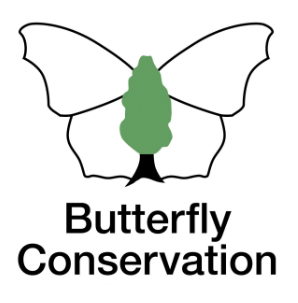Brown Argus
Brown Hairstreak
Chalkhill Blue
Clouded Yellow
Comma
Common Blue
Dark Green Fritillary
Dingy Skipper
Essex Skipper
Gatekeeper
Green Hairstreak
Green-veined White
Grizzled Skipper
Holly Blue
Large Skipper
Large White
Marbled White
Meadow Brown
Orange-tip
Painted Lady
Peacock
Purple Emperor
Purple Hairstreak
Red Admiral
Ringlet
Silver-washed Fritillary
Small Blue
Small Copper
Small Heath
Small Skipper
Small Tortoiseshell
Small White
Speckled Wood
Wall
White Admiral
White-letter Hairstreak
Extinct/rare immigrants
Common Blue
Polygonia c-album
General Distribution and Status
The Common Blue is widespread and common except on the mountainous areas in Scotland and Wales. Both range and abundance have declined slightly since 1976 but have stabilised since 2005 (Fox et al.) although a worrying decline has occurred since around 2015. It is thought that many colonies were lost in the arable areas of eastern England through farming intensification in the last few decades of the 20th century (Asher et al.). In Hertfordshire and Middlesex, it is still a common butterfly and although populations are smaller than the 1990s it is colonising new sites even in urban areas. The 1990s saw an increase in numbers until 1998 when it suffered badly probably due to the wet weather in June that year. Since 2003, it has recovered well both in range and abundance despite the run of poor summers in the middle of the 2010s. 2018 saw substantial increases in numbers at many locations but the trend is generally negative.
| United Kingdom | Herts & Middx | |||
| Distribution | 1976-2019 | -37% | 1980-2015 | +1% |
| Average 10-year trend | -9% | 2006-2015 | +33% | |
| 2024 since 2015-19 | -19% | |||
| Abundance | 1976-2024 | -29% | 1980-2015 | -18% |
| 2015-2024 | -43% | 2006-2015 | -8% | |
| 2023-2024 | -47% | 2024 since 2015-19 | -56% | |
UK distribution map
UKBMS Species summary
Habitat Requirements
Open grassy areas where the larval foodplant Common Bird's-foot Trefoil Lotus corniculatus grows although other plants may be used - see below.
Larval Foodplants
Common Bird's-foot Trefoil L. corniculatus. Other plants such as Greater Bird's-foot Trefoil L. uliginosis on wetter soils, Lesser Yellow Trefoil Trifolium dubium, Black Medick Medicago lupulina and Common Restharrow Ononis repens have also been recorded (Sawford).
Adult Food Sources
Common Bird's-foot Trefoil L. corniculatus (269), Garden Lavender Lavandula x intermedia (127), Heather Calluna vulgaris (89), Thistles Cirsium sp. (84).
Historical Records
In 1902, Gibbs states that it 'occurs very generally throughout the county' and Foster in 1934 describes it as 'usually abundant'. However, the decline in numbers probably started in the 1950s when changes in agricultural practices resulted in loss of suitable habitat (Sawford) but it was probably still very widespread a decade later. It might have occurred in every tetrad in the county since its principal larval foodplant Common Bird's foot Trefoil L. corniculatus was found to be as widely distributed (Dony) although no indication of the plant's abundance was given. Waterton in his 1970-81 report refers to it as 'still fairly common and widespread but nowhere nearly as abundant as it was ten to 15 years ago'. The desiccation of the foodplant in the hot dry summer of 1976 is the most probable reason for the significant decline.
Local Distribution and Abundance
As indicated on the map, the butterfly has been found in every tetrad in the Stevenage district although in most places numbers are usually quite low. The best sites are Frogmore Gravel Pit, the western part of Knebworth Park, Great Ashby Park, Shackledell Grassland and the field adjoining Watery Grove. In 2018 the brownfield site at Arlington Business Park off Six Hills Way near the A1 attracted good numbers, e.g. 59 on 9 June. In fact, 2018 proved to be the best year during the survey period with 161 reports including several in September and October. However, since that bumper year, fortunes have changed dramatically with far fewer specimens seen and in 2024 not one site yielded more than 5 specimens on any one visit.

Stevenage (South Fairlands Valley Park) transect 1993-2025
Records show that numbers of Common Blue increased slightly since the start of the survey in spite of disappointing figures between 2000 and 2005, 2007-8 and 2011-12 when the summers were cooler and wetter than usual. 2019 proved to be a poor year especially regarding the second brood probably impacted by the apparent lack of healthy larval foodplants in early summer when it was very dry. The drought in the spring of 2020 exacerbated the situation with only nine recorded for the year. 2021 saw even lower numbers of four, equal with 2012, the worst since 2007. There was a welcome boost in numbers in 2022 but the extremely wet weather in the first half of 2024 provided ideal conditons for coarse grasses to grow and inhibiting healthy growth of many foodplants for the larvae to survive. Only four adults were counted in that year. Dry and warm weather in 2025 fortunately reversed the recent decline. The best site is now Shackledell Grassland where an annual cutting regime was implemented in 2011 removing the coarser grasses and scrub which were encroaching the meadow. Some less vigorous plants like the larval foodplant are now thriving as a result and benefiting the butterfly. The odd Common Blue was seen in Whomerley Wood in the early and mid 1990s but shrubs were soon taking over. In the last few years sections of Whomerley Wood at the southern end have been cleared which may encourage the butterfly to return.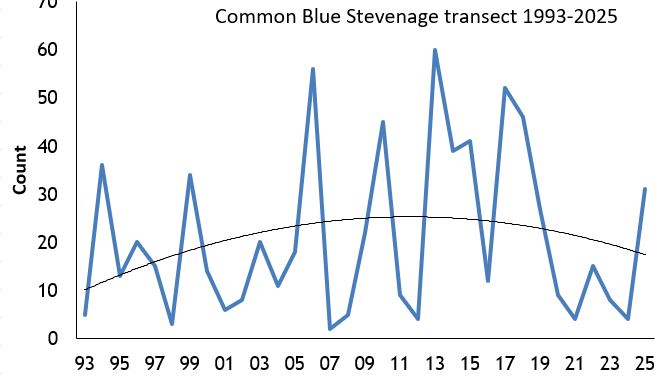
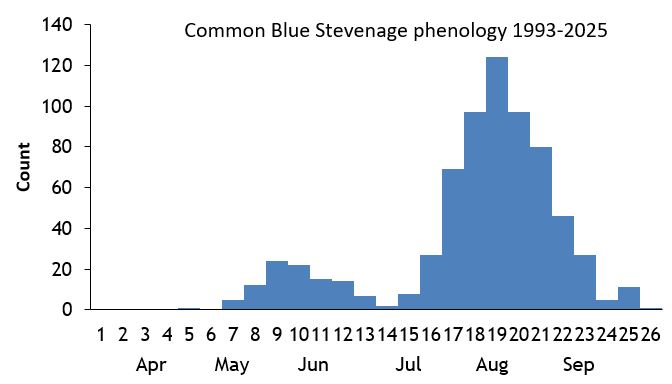
Knebworth Park transect 1996-2010 and 2017-2025
The cool summers of 2007 and 2008 impacted the numbers in this transect otherwise the trend appears to be positive in spite of the lack of records between 2011 and 2016. The year 2017 was the most successful with 77 records most of which were found in the north-west section of the park. In 2019, the late summer brood was very disappointing perhaps caused by the early summer weather as explained for the Stevenage transect. A massive drop in numbers in 2020 was probably caused by excessive grazing by deer in the park itself (evidenced by numerous deer droppings) as well as the effect of the drought in the spring.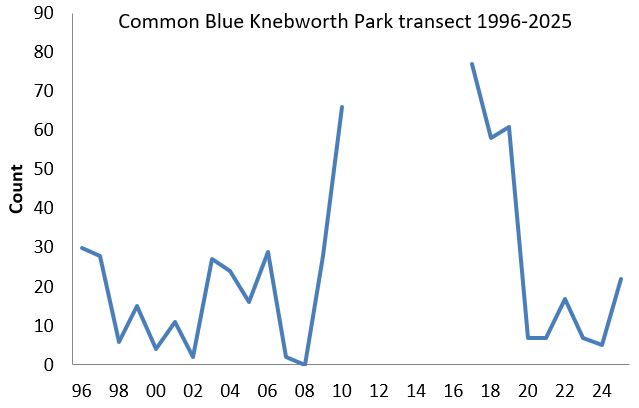
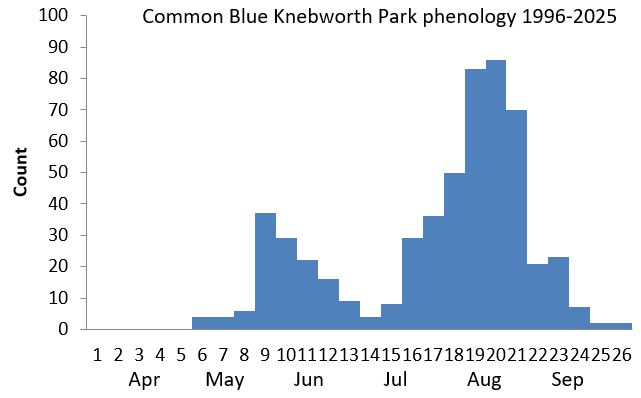
Knebworth Woods transect 2017-2025
Most specimens were found in the meadow at Norton Green Common where over 20 were recorded on both 1 and 8 August 2018 although none were found across the whole transect in the spring in that year. Burleigh Meadow is another good spot but numbers were suppressed in 2018. The meadow was not cut or grazed earlier in the year thus allowing taller and coarser grasses to take over and preventing the food-plant, Bird's-foot Trefoil, to thrive. Very low numbers were observed in 2019 and only one specimen was recorded in 2020. Even after the cuts in late 2018 and 2019, there was still very little Bird's-foot Trefoil in the grassy places. Perhaps the droughts in the springs of 2019 and 2020 dessicated the food-plants. Although there was a pick up in numbers in 2022 the butterfly continues to fare poorly here due to habitat degradation.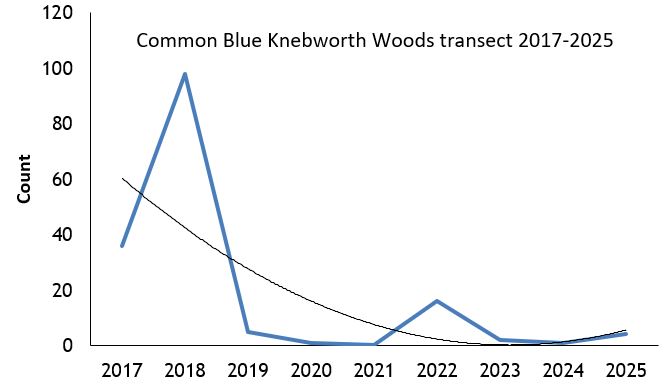
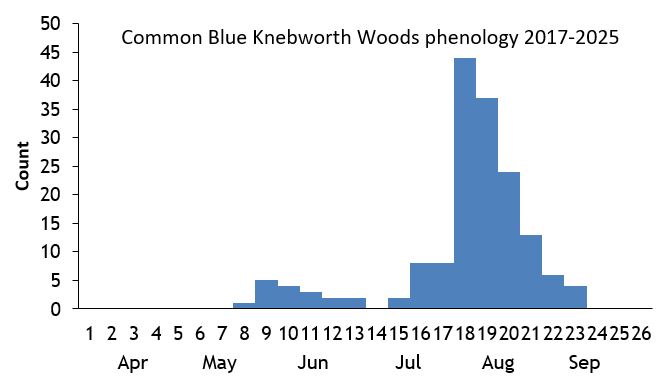
Pryor's Wood transect 2000-2022
Most records so far are of singletons: 2003 (1 record), 2004 (2), 2005 (1), 2010 (3), 2016 (3), 2017 (1), 2022 (1) but in 2020, nine were seen on 31 July.Life History
Earliest date: 5 May 1995 at Shackledell Grassland
Latest date: 24 October 2018 near Watery Grove
There are two broods every year with the
second generation usually seen in greater numbers. Peak numbers are often recorded in the last
week of May and first week of June for the first brood, and early to mid August for the second generation. The 24 October sighting in 2018 is the latest
ever by nearly three weeks, which is probably indicative of a third generation. Females lay eggs on the leaves
on which the caterpillars feed underneath. Larvae attract the attention of ants when fully grown. Pupae are formed on the ground, sometimes close to
ants' nests. The butterfly overwinters in the larval stage.
Behaviour/Observation notes
The female Common Blue can look very much like a Brown Argus. Aside from the different spot patterns on the undersides for the two species, the best way to distinguish between them, another clue is the flight behaviour. Brown Argus is usually more skittish and appears silvery-grey whereas the female Common Blue makes slow flights between resting/nectaring and looking for places to lay her eggs.
Variations/Aberrations
The males vary slightly in the blue ground colour but females can be dusky-brown or any shade of blue. I found a pale blue example of a female in the
meadow at Norton Green Common on 15 September 2014 as shown in the photo on the right. The variation in the marginal orange spots is extensive and the
spots can be very large and bright or absent.
Find out more on the UK Butterflies website
References
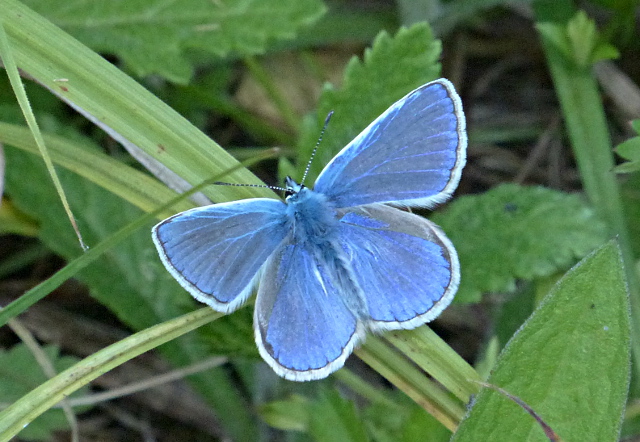
Norton Green Common 28 May 2017 (m)
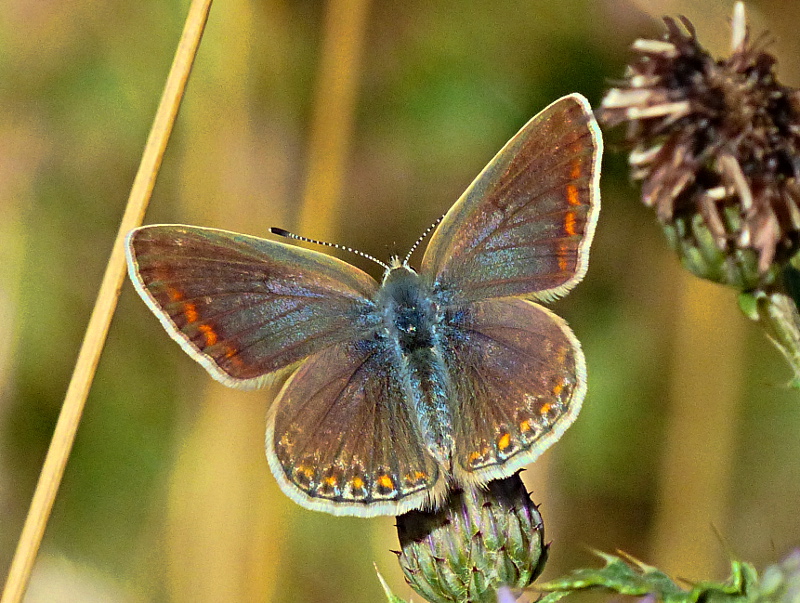
Norton Green Common 2 Aug 2018 (f)
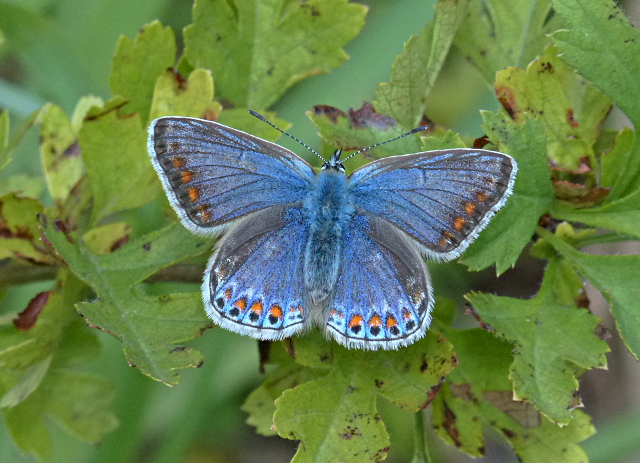
Shackledell 16 Aug 2017 (f)
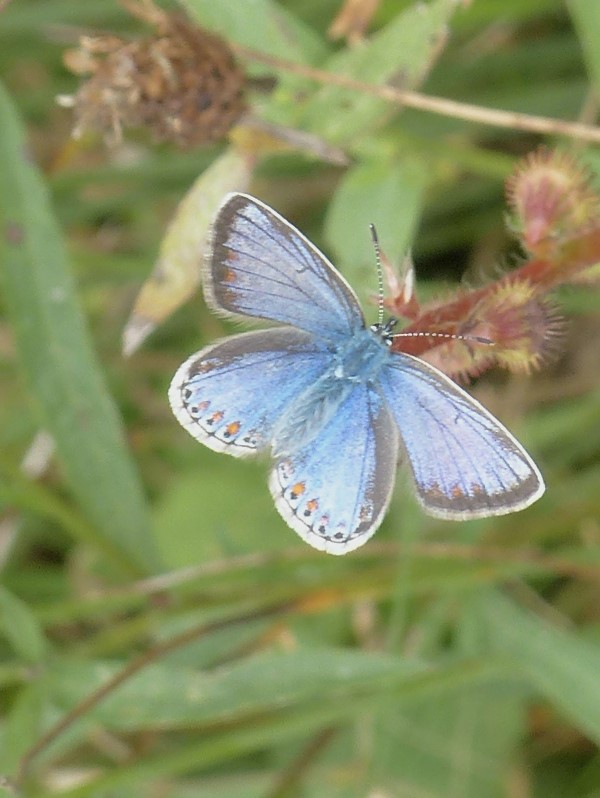
Norton Green Common 15 Sep 2014 (f)
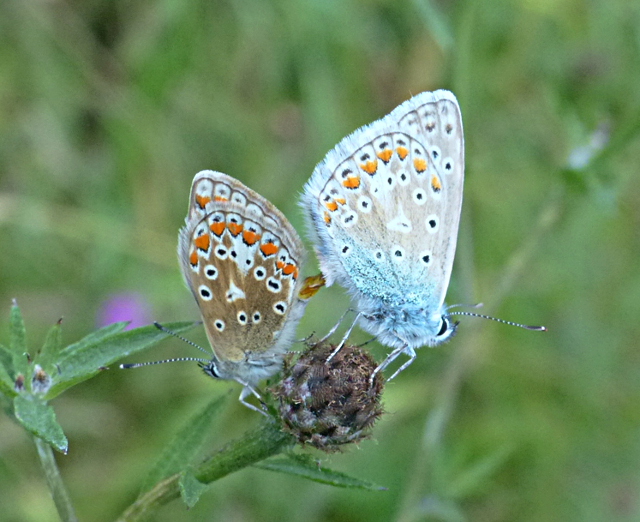
Near Watery Grove 28 Jul 2017
